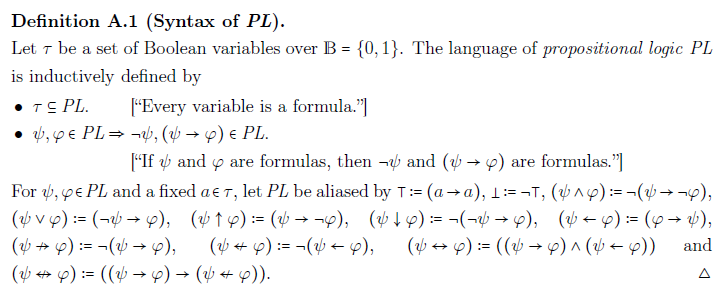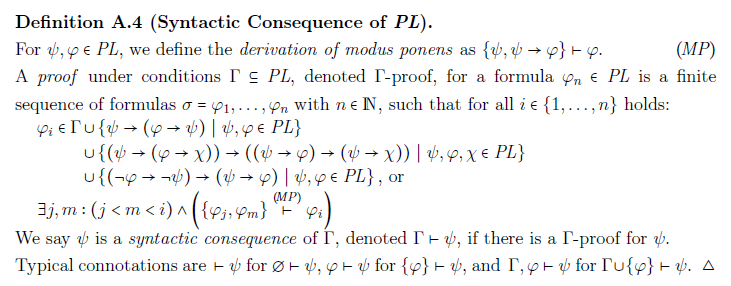Uncomfortable with definitions as axioms ... help?
Samuel Goto
Mario Carneiro
Hey all,As I'm looking into metamath there is something lingering that is making me uncomfortable: definitions are axioms.This is obviously intended and by design by the community (the book has a whole chapter about it), but I'm still uncomfortable with the justifications and consequences.
A few irrational feelings I think I'm having:- I can't parse or understand df-bi trivially. What does it mean?
- How do I know that the axioms of the definitions aren't introducing contradictions?
- It seems that definitions aren't supposed to "extend the language", but I don't get that sentiment as I read them
- We say "all you need is propositional and first order logic and set theory axioms" but then proceed to introduce a bunch by definitions
I'm sure this can't be a new sentiment, since an entire chapter in the book was dedicated to it, but I was wondering if:(a) Does anyone have some explanation posted online that I could read to inform myself and perhaps settle my anxiety?(b) Is there a version of metamath and/or set.mm that don't rely on definitions as axioms?
Marshall Stoner
Marshall Stoner
Discher, Samiro
I was also disturbed by the issue of definitions being extra axioms according to Metamath, and solved it via interpreting only 'not' and 'imply' as part of the propositional core language, and all the other junctors as different ways to express something in terms of 'not' and 'imply' (which is also done in https://us.metamath.org/mmsolitaire/pmproofs.txt when proving statements which contain different junctors, see "Result of Proof" lines which differ from their theorems).
The concept to build only on what is essentially required leads to much slimmer definitions that make use of a logical system (e.g. when defining semantics).
Here is one of my exemplary syntax definitions:

Alias step verifications can be done by converting both formulas into the core language and checking for equality.
Based on
(A1) ⊢\psi\imply(\phi\imply\psi)
(A3) ⊢\not\phi\imply\not\psi\imply(\psi\imply\phi)
(MP) {\psi,\psi\imply\phi}⊢\phi
1. \phi\imply(\psi\imply\chi) premise
2. \phi\imply(\psi\imply\chi)\imply(\phi\imply\psi\imply(\phi\imply\chi)) (A2) ; 〈\phi, \psi〉, 〈\psi, \phi〉
3. \phi\imply\psi\imply(\phi\imply\chi) (MP):1,2
mms-H6:
1. \not1\imply\not2\imply(2\imply1) (A3) ; 〈\phi, 1〉, 〈\psi, 2〉
2. \not1\imply\not2\imply(2\imply1)\imply(0\imply(\not1\imply\not2\imply(2\imply1))) (A1) ; 〈\phi, 0〉, 〈\psi, \not1\imply\not2\imply(2\imply1)〉
3. 0\imply(\not1\imply\not2\imply(2\imply1)) (MP):1,2
4. 0\imply(\not1\imply\not2\imply(2\imply1))\imply(0\imply(\not1\imply\not2)\imply(0\imply(2\imply1))) (A2) ; 〈\chi, 2\imply1〉, 〈\phi, \not1\imply\not2〉, 〈\psi, 0〉
5. 0\imply(\not1\imply\not2)\imply(0\imply(2\imply1)) (MP):3,4
mms-T13:
1. \not\not0\imply(1\imply\not\not0) (A1) ; 〈\phi, 1〉, 〈\psi, \not\not0〉
2. \not\not0\imply(\not\not(1\imply\not\not0)\imply\not\not0) (A1) ; 〈\phi, \not\not(1\imply\not\not0)〉, 〈\psi, \not\not0〉
3. \not\not0\imply(\not\not(1\imply\not\not0)\imply\not\not0)\imply(\not\not0\imply(\not0\imply\not(1\imply\not\not0))) (mms-H6) ; 5 ; 〈0, \not\not0〉, 〈1, \not(1\imply\not\not0)〉, 〈2, \not0〉
4. \not\not0\imply(\not0\imply\not(1\imply\not\not0)) (MP):2,3
5. \not\not0\imply(\not0\imply\not(1\imply\not\not0))\imply(\not\not0\imply(1\imply\not\not0\imply0)) (mms-H6) ; 5 ; 〈0, \not\not0〉, 〈1, 0〉, 〈2, 1\imply\not\not0〉
6. \not\not0\imply(1\imply\not\not0\imply0) (MP):4,5
7. \not\not0\imply(1\imply\not\not0\imply0)\imply(\not\not0\imply(1\imply\not\not0)\imply(\not\not0\imply0)) (A2) ; 〈\chi, 0〉, 〈\phi, 1\imply\not\not0〉, 〈\psi, \not\not0〉
8. \not\not0\imply(1\imply\not\not0)\imply(\not\not0\imply0) (MP):6,7
9. \not\not0\imply0 (MP):1,8
mpd:
1. \phi\imply\psi premise
2. \phi\imply(\psi\imply\chi) premise
3. \phi\imply\psi\imply(\phi\imply\chi) (a2i):2 ; 3
4. \phi\imply\chi (MP):1,3
id:
1. \phi\imply(\phi\imply\phi) (A1) ; 〈\psi, \phi〉
2. \phi\imply(\phi\imply\phi\imply\phi) (A1) ; 〈\phi, \phi\imply\phi〉, 〈\psi, \phi〉
3. \phi\imply\phi (mpd):1,2 ; 4 ; 〈\chi, \phi〉, 〈\psi, \phi\imply\phi〉
mms-T35:
1. \not\not(0\imply1)\imply(0\imply1) (mms-T13) ; 9 ; 〈0, 0\imply1〉
2. \not\not(0\imply1)\imply(0\imply1)\imply(\not\not(0\imply1)\imply0\imply(\not\not(0\imply1)\imply1)) (A2) ; 〈\chi, 1〉, 〈\phi, 0〉, 〈\psi, \not\not(0\imply1)〉
3. \not\not(0\imply1)\imply0\imply(\not\not(0\imply1)\imply1) (MP):1,2
mms-*4.2:
1. P\implyP (id) ; 3 ; 〈\phi, P〉
2. P\implyP\imply(\not\not(P\implyP\imply\not(P\implyP))\imply(P\implyP)) (A1) ; 〈\phi, \not\not(P\implyP\imply\not(P\implyP))〉, 〈\psi, P\implyP〉
3. \not\not(P\implyP\imply\not(P\implyP))\imply(P\implyP) (MP):1,2
4. \not\not(P\implyP\imply\not(P\implyP))\imply(P\implyP)\imply(\not\not(P\implyP\imply\not(P\implyP))\imply\not(P\implyP)) (mms-T35) ; 3 ; 〈0, P\implyP〉, 〈1, \not(P\implyP)〉
5. \not\not(P\implyP\imply\not(P\implyP))\imply\not(P\implyP) (MP):3,4
6. \not\not(P\implyP\imply\not(P\implyP))\imply\not(P\implyP)\imply(P\implyP\imply\not(P\implyP\imply\not(P\implyP))) (A3) ; 〈\phi, \not(P\implyP\imply\not(P\implyP))〉, 〈\psi, P\implyP〉
7. P\implyP\imply\not(P\implyP\imply\not(P\implyP)) (MP):5,6
8. \not(P\implyP\imply\not(P\implyP)) (MP):1,7
9. P\equivP alias:8
df-bi:
1. \phi\equiv\psi\equiv(\phi\equiv\psi) (mms-*4.2) ; 9 ; 〈P, \phi\equiv\psi〉
2. \not(((\phi\equiv\psi)\imply\not((\phi\imply\psi)\imply\not(\psi\imply\phi)))\imply\not(\not((\phi\imply\psi)\imply\not(\psi\imply\phi))\imply(\phi\equiv\psi))) alias:1

However, the theory is nice and clean this way, which I think was the focus here.
Gesendet: Samstag, 8. Juli 2023 23:40:22
An: Metamath
Betreff: Re: [Metamath] Uncomfortable with definitions as axioms ... help?
You received this message because you are subscribed to the Google Groups "Metamath" group.
To unsubscribe from this group and stop receiving emails from it, send an email to metamath+u...@googlegroups.com.
To view this discussion on the web visit https://groups.google.com/d/msgid/metamath/a3d5056d-9e16-4678-af16-1a91431bbffcn%40googlegroups.com.
Marshall Stoner
Mario Carneiro
I trust that intuitively that these definitions are valid. The problem is an alias rule can still fail if the syntax of the definition doesn't meet certain criteria. If the parenthesis surrounding ↔ were missing in the definition of the biconditional, for instance. If I could understand how the definition checker for the set.mm database works I would have a better understanding. I have my own hypothesis, but I'm not sure if it's fully sufficient.
Discher, Samiro
"The problem is an alias rule can still fail if the syntax of the definition doesn't meet certain criteria. [...]"
Maybe I should've been clearer about the syntax definition. In my theory, one can skip a lot of parentheses since I considered left first
bracketing, which I explained prior to that definition. Metamath however enforces formulas of a style with fixed parentheses and would thereby deny any input where formulas omit or introduce those.
Formulas are actually tree structures, for example the theorem of df-bi has the following syntax tree:

You could put parentheses around formulas in infinitely many correct ways, while not changing the identity of the formula. That has nothing to do with intuition, but is well-defined based on bracketing order, as well as order of order of precedence for operators (but in this case, all binary operators share the same priority, and it doesn't matter for nullary and unary operators).
Parentheses in logic work just the same as in all kinds of mathematical formulas, they merely prescribe order of operation. Some kind of solvers (such as Metamath) rule this out for efficiency or ease of implementation, but that is a technical
detail that is rather disruptive and inelegant in a theoretical context.
All the alias replacement rules are well defined, regardless of which parentheses were used. If the parentheses change in the way that the identity of the formula (here: the order of operations) changes, the corresponding rules simply do not apply anymore.
My solution was merely meant to answer your questions on how df-bi can be justified via a rigorous proof from Metamath's propositional axioms. I have no better understanding in how Metamath's "definition checker" works than definitions being treated merely as axioms, as has been confirmed by multiple people in this thread.
Additionally, I understand that these definitions are well-justified, which is also pointed out, for example, in the description of df-bi ( see https://us.metamath.org/mpeuni/df-bi.html ).
I have provided you with a proof for that.
Marshall Stoner
Marshall Stoner
Mario Carneiro
--
You received this message because you are subscribed to the Google Groups "Metamath" group.
To unsubscribe from this group and stop receiving emails from it, send an email to metamath+u...@googlegroups.com.
To view this discussion on the web visit https://groups.google.com/d/msgid/metamath/1c92e482-fcee-4659-a858-076edb89d6e5n%40googlegroups.com.
Discher, Samiro
Apart from some missing spaces, these formulas are in LaTeX format, and reasons are nicely indented for text editors.
You could simply use
\def\not{\lnot}
\def\equiv{\leftrightarrow}
\def\imply{\rightarrow}
\def\phi{\varphi}
in the .tex file and insert spaces when [a-zA-Z] rather than [0-9] follows a command via regex-search-and-replace. More seach-and-replace can put it into any desired LaTeX commands.
If you have issues reading LaTeX-formatted formulas, you can also use search and replace to convert it to unicode, e.g. replace all "\imply" by "→", all "\phi" by "φ", and so on.
I used my own converter on my example, which makes some explicit information (like substitutions and referenced line numbers - useful for programs) implicit, but makes it even easier to read as a human. I am sending the resulting .tex file.
Here is what it looks like when parsed: https://i.imgur.com/a31LACW.png
Hope this helps.
Marshall Stoner
Thanks. I got it. I'm rusty with LaTex and forgot about redefinition commands. It was late when I looked so I gave up when I got errors.
Discher, Samiro
According to
https://math.stackexchange.com/questions/1123312/theory-of-definitions,
(referencing the same book as the question you mentioned) these properties are required by all definitions, and there are also some criteria listed and explained for a certain type of definition. Maybe this is a lead in the right direction?
I wonder how useful the ability to use aliases instead of axiomatic definitions is in detecting
those properties as well, but given that I invented aliases myself and haven't seen them in any textbook, I don't know of anyone who studied this and, if so, how they called it.
